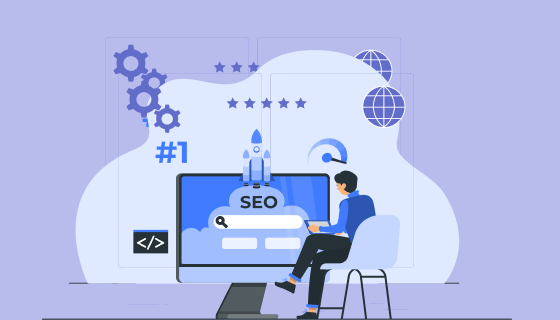On average, the conversion rate of websites ranges from 2-3%. However, for the top-performing sites, it can rise to up to 11%.
As a brand, there are various measures you can take to enhance your website’s performance. Among them, end user optimization is a great option.
It helps enhance your audience’s experience and makes your site mobile-friendly. Considering that most people access the internet using
mobile devices, optimization is essential.
Optimizing your site goes beyond improving its performance. It also enhances user experience (UX), encouraging users to spend more time on your site. This then boosts your search engine rankings, giving you access to a larger audience.
Whether you’re a digital marketer or website owner, you need to focus on end user optimization. As it elevates UX, it will give you an edge over rivals.
So, keep reading to gain valuable insights and practical tips to improve your site’s UX and SEO.
What Is End User Optimization?
End user optimization is the process of improving a site’s user-friendliness and ranking. Its goal is to provide a seamless user experience that keeps visitors on your site longer. In so doing, optimization encourages traffic to explore more content and convert.
As such, it’s a holistic process encompassing UX design principles and SEO strategies.
It involves:
- Creating an intuitive navigation structure
- Implementing a responsive design that adapts to various devices
- Ensuring fast loading times
As you can see, user optimization goes beyond pleasing your visitors. It’s also about improving site performance. When your site performs well, search engines take it as a sign that your content is high-quality.
This can boost your site’s visibility on search engine result pages (SERPs). As a result, you can expect more traffic and leads. Hence, end user optimization is a crucial aspect of web development. By intertwining the user’s needs with SEO objectives, it boosts performance.
Why Should We Improve End User Optimization?
There are over 1.5 billion websites in the world today. Among them, 200 million are active and competing for the same audience. Thus, your site needs to stand out to attract your target audience.
This is where end user optimization is crucial. By influencing SERP rankings, it determines how visible your brand will be. Moreover, it helps keep your visitors scrolling and interacting with your content longer.
For your website to meet such standards, it needs to be:
- Intuitive
- Easy to navigate
- A valuable resource for visitors
The advantages of a user-friendly website are manifold, including:
- It enhances user satisfaction: Visitors will likely return and stay loyal if your website is easy to use.
- It lowers bounce rates: If your website is not easy to navigate, users will not stay for long. As this continues to happen, it will impact your SEO rankings.
- User-friendly sites can increase your conversion rates: Easy-to-use sites give customers room to explore your services and purchase. Also, happy clients are more likely to come back and tell others about your website.
- Search engines favor user-friendly websites: Offering a great user experience makes your site seem reliable to search engines. This will then improve your search engine rankings and visibility.
Creating a website that is easy to use is great for both UX and SEO. It enhances users’ experience and improves your website’s visibility. In turn, as your rankings improve, it will make your brand seem more credible to your audience.
5 Principles of User Optimization
Now that you understand the value of end user optimization, it’s time to know how to achieve it.
There are five principles that you should observe. They range from optimizing page speed to delivering high-quality content. While you can apply each principle independently, you need to do so concurrently.
If there’s something that can impact bounce rates, it’s page load speed. You’ll lose traffic for each extra second your site takes to load.
Thus, one of the key cornerstones of user optimization is fast loading times. When your site loads quickly, users will have a hassle-free browsing experience. This will allow you to hold their attention for longer. In turn, your bounce rate will reduce while the average time spent on your site increases.
Fast loading time is also great for keeping mobile users. Since they’re often on the move and need quick access to information, you’ll meet their needs.
From an SEO perspective, fast loading times are an invaluable asset. This is because search engines like Google use algorithms that focus on it. As your ranking improves, you’ll notice a rise in organic traffic, leads, and sales.
In web design, user experience and navigation are vital elements. The easier it is for visitors to navigate your website, the longer they stay and the more likely they will return.
So, the first thing you’ll need to optimize your website is an intuitive framework. It will guide users to the right pages, increasing the quality of browsing sessions.
Some of the features that you can expect with an intuitive framework include:
- Smooth transitions
- Distinct labeling
- Logical formatting
In addition to these great features, you’ll also need website navigation tools such as search bars. These will help users find their way from one page to another without issues.
Furthermore, you’ll also need to understand user behavior to optimize website performance. You can achieve this by analyzing metrics such as average time on page and return visitors. From the insight you gain, you can optimize your strategy to suit your unique needs.
Unlike in the past, consumers can access the internet using various devices. These range from desktops and laptops to tablets and mobile phones. Each device has unique requirements when it comes to optimal website performance.
For instance, some web pages appear without issues on desktops. But if they’re not optimized for mobile, the same page will seem distorted on a smaller device. This is why your web design should be responsive.
By improving responsiveness, your website will adjust to suit different screen sizes. Therefore, regardless of the device a lead uses, you’ll deliver a good user experience.
As you focus on a responsive design, remember it’s not only about aesthetics. Your efforts should focus on improving functionality, as navigation issues increase bounce rates. Moreover, a mobile-friendly website aids SEO performance.
In the digital ecosystem, you need a robust content strategy to remain relevant. It should focus on providing engaging, informative, and optimized content. Beyond SEO, good content is also crucial for user optimization.
For your content strategy to thrive, focus on educating and solving user problems. The more value you offer, the longer they’ll stay on your site and explore. Moreover, high-quality content enhances your brand’s credibility.
With regard to SEO, don’t forget to infuse your content with keywords. These are words that help search engines associate your content with search queries. On the flip side, you should adopt healthy keyword practices to avoid negative SEO.
Here are some quick tips for creating a memorable content experience:
- Understand your audience: Know who your users are and what they want. Use this information to tailor your content to meet their needs and interests.
- Provide valuable information: Ensure your content is informative and answers users’ queries. This can position you as an authority in your field.
- Engage your audience: Incorporate interesting facts, story-telling, and other creative elements to keep your audience engaged.
- Optimize for SEO: Use relevant keywords within your content. Also, don’t forget about meta tags and alt text for images.
- Update regularly: Keep your content fresh and up-to-date. This shows your users (and search engines) that your site is active and reliable.
Crafting a memorable content experience is an ongoing process. You need to ensure loyal followers have a consistent stream of content. This is a simple strategy that keeps you top of mind with your audience and strengthens your brand.
However, to achieve this, you must ensure content resonates with your audience. So, use performance metrics and feedback to determine what works best and focus on it.
CTA buttons are vital in website design. They help users engage and convert. But it’s not only about telling users what to do and when. Their goal is to guide users further along the buying journey, from interest to sale.
As such, they should be positioned strategically and use clear and actionable language. This should be accompanied by responsiveness across all devices to boost results. With such CTAs, you’ll reduce friction in the conversion process, increasing performance.
Stay Ahead of the Competition
When building a strong digital presence, SEO and end user optimization go hand in hand. From quick load times to intuitive navigation, there are key areas you should focus on. These will help you deliver a seamless user experience, boosting engagement and rankings.
They should be accompanied by a robust content strategy to engage and inform users. Along with being engaging, optimize your content to improve ranking on SERPs. As more people engage with your content, ensure your CTAs will drive them to action.
By taking these steps, you’ll be well into your user optimization journey. However, keep in mind that user optimization requires consistent monitoring and fine-tuning. It’s only by working on it consistently that your site’s performance and ranking will improve.
Need help with website management? You can count on our Website Optimization service to help you build a formidable online presence. We use the best UX/UI, CRO, and SEO practices to give you a fully functioning website. In turn, this will translate to higher-quality leads that will propel your brand forward.
Our Website Optimization service includes:
- SEO
- User experience
- Content
- Design
- Conversion Rate Optimization (CRO)
- Analytics & Tracking
- Technical SEO
Dec 05, 2023




Rachel
I’m an online marketing professional with over 10 years of experience. I have a background in web development and SEO, which I leverage to provide high-quality content strategy and content creation for businesses.